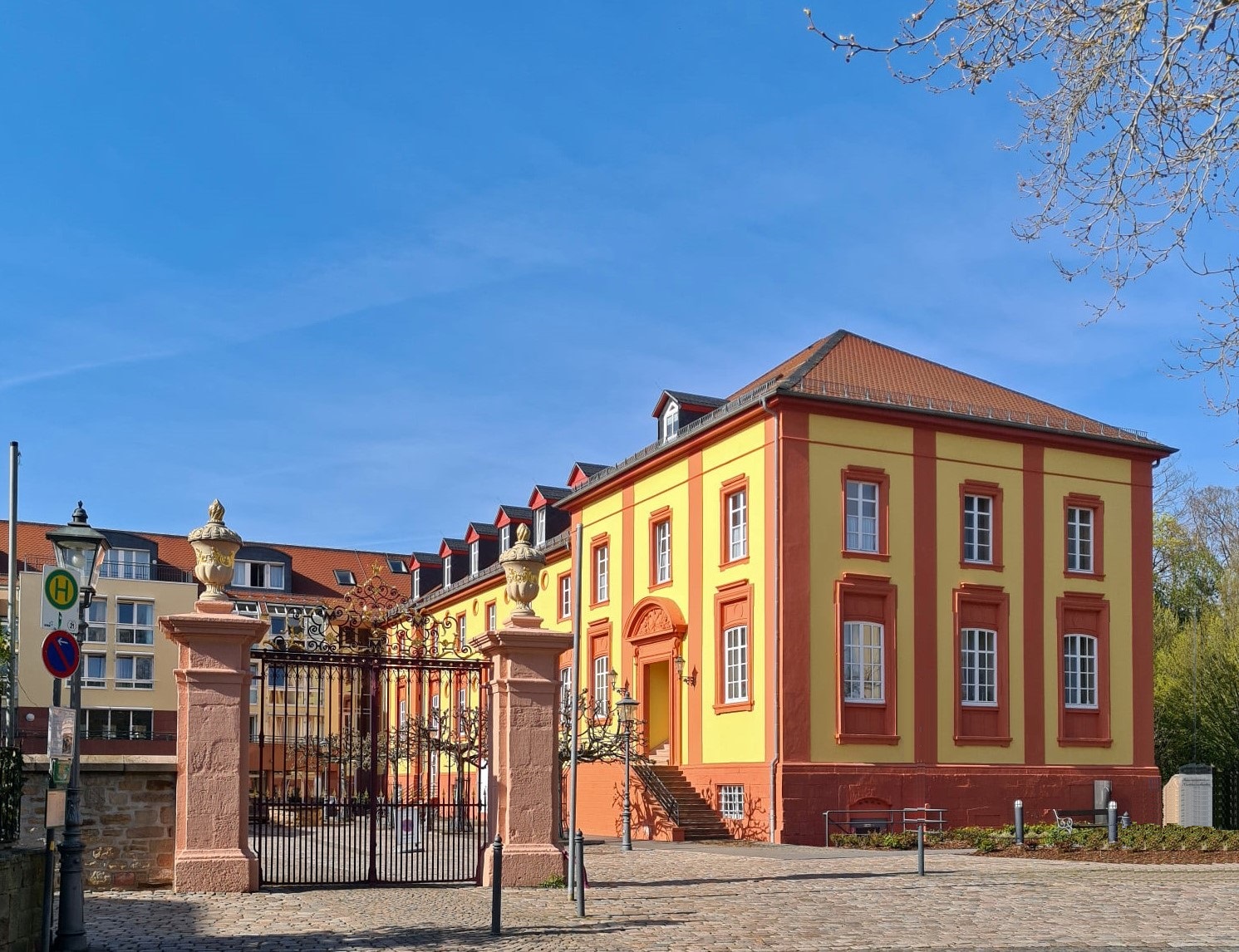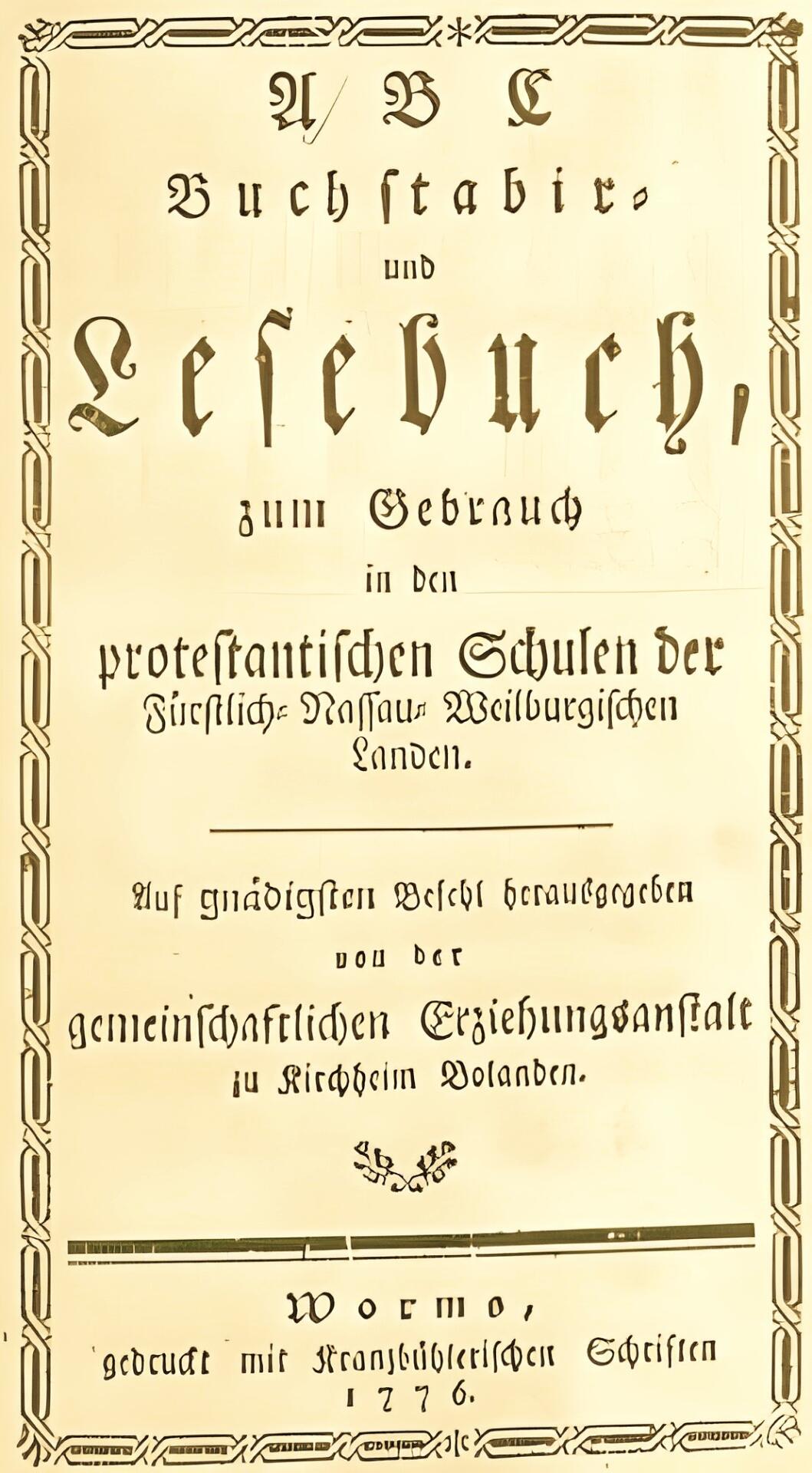Residential Palace
Kirchheimbolanden Residential Palace
A three-winged palace complex with a cour d’honneur open to the town was planned for Kirchheimbolanden. However, only the 55 long eastern (right) side wing and the eastern (right) part of the middle wing were realized in 1706/09.
However, the fact that this construction was not continued under Count Johann Ernst von Nassau-Weilburg (r. 1675-1719) may have been mainly due to the extremely costly baroque extension of the Weilburg castle complex.
The Kirchheimbolander castle therefore initially remained a torso. It was not until Count/Prince Carl August (reigned 1719-53) that the three-winged complex begun by his father was completed.
The castle went up in flames as early as 1792. For the French revolutionary troops, it was a symbol of the old monarchical order. The stele of the Mozart Fountain in the suburb commemorates this [Standort 43].
However, only the first floor of the east wing of the baroque palace complex is original. It was therefore a fortunate coincidence that in 1994/95 it was possible to combine what had been handed down (the east wing, rebuilt several times in 1807, 1861/62 and 1910) with what was new (the middle and west wings) and thus get an idea of the extent of the Baroque palace complex.


French architectural fashion
A lithograph of the Kirchheimboland castle garden wing made in the 19th century before 1861 shows the architectural design of the Nassau-Weilburg court architect Julius Ludwig Rothweil. The high windows of the first floor, which rests on a basement, dominate the scene. The building is crowned by a two-storey mansard roof.
After a fire in 1861, however, this architectural structure was overstretched. The first mansard attic floor is now converted into a regular upper floor and a hipped roof is placed above it in the style of the 19th century.
As a result, the garden front of today’s palace building only conveys a partial image of the original planning and construction. In the lithograph, however, Rothweil’s decisive art-historical references to the Versailles palace style of the late 17th century, whose trend-setting form was shaped by Jules Hardouin-Mansart (1646-1708), become apparent. The model for Kirchheimbolanden is Glagny, the palace built for the Marquise de Montespan in the Versailles area.
As the “French taste” was influential for Rothweil from the very beginning, he also realized an early work of this fashion on German soil in Kirchheimbolanden. In doing so, he took up building ideas that he had first realized in 1700/02 in Schloss Philippsruhe in (Hanau-) Kesselstadt am Main. Here, elements from Glagny (single-storey, mansard roof) are prefigured in the wing buildings for the Kirchheimbolanden palace project, which thus represents not only a stage in Rothweil’s architectural development, but also an intermediate stage in the transfer of the “French fashion” to Germany.

32.3 The Kirchheimbolander Princes of Nassau-Weilburg
Kirchheimbolanden was the residence town of three Nassau-Weilburg princes in the 18th century.
The two most influential princely couples were Carl August and Auguste Friederike Wilhelmine and Carl Christian and Caroline. They are depicted on the stele of the Mozart Fountain in the suburb [Standort 43].
CARL AUGUST
* September 17, 1685 in Weilburg; † November 9, 1753 in Weilburg; stays in Versailles from 1699 to 1701; assumed the throne as Count of Nassau-Weilburg in 1719; elevated to the rank of Prince of the Empire in 1737.
During his reign, Kirchheimbolanden saw the completion of the castle, St. Paul’s Church, the Ballhaus and the Amtsstraße.
In the spirit of his time, he promoted the expansion of the state. This is expressed, for example, in his “Poor Law” in 1734 or his “School Regulations” in 1737. Carl August was guided by the understanding of the state of the early Enlightenment. In the “School Regulations”, for example, he established compulsory school attendance from Michaelmas (September 29) to May. Unexcused absences are punished with a fine.
His church policy is characterized by tolerance, for although he himself is a Lutheran, the Reformed congregation is to be accorded all the privileges hitherto enjoyed by the Lutheran congregation alone and no further distinction is to be made in future (decree of 13 January 1738).
CARL CHRISTIAN
* January 16, 1735 in Weilburg; took office in 1753; † November 28, 1788 at the Münsterhof in Dreisen near Kirchheimbolanden.
Under his reign, the Neue Allee and the Orangerie were built in Kirchheimbolanden.
His social policy is exemplary for the 18th century. For example, he provided for the surviving dependants of his civil servants by establishing three widow’s funds (for secular civil servants, clergy and teachers) and setting up a poor fund to eliminate begging.
However, the subjects were dismissive of innovations in the church or school sector. For example, Carl Christian was only able to enforce the introduction of a primary school reading book, which was to be binding for Lutherans and Reformed alike, by force of arms (“ABC book” dispute of 1777) [Standort 43].
During his reign, Kirchheimbolander Palace becomes the “Court of the Muses”. It was mainly designed by Carl Christian’s wife Caroline (1742-87). The visit of Wolfgang Amadeus Mozart (1778) [Standort 32.6] can therefore be attributed to her and her courtly “Musique flair”.
FRIEDRICH WILHELM
* October 25, 1768 in The Hague; took office in 1788; † January 9, 1816 in Weilburg.
His reign left no architectural traces in Kirchheimbolanden.
In September 1792, French revolutionary troops were advancing on the town. The princely family – and with them the entire court – fled to the remaining Nassau territory on the right bank of the Rhine, while a profound political change took place in Kirchheimbolanden, which found its symbolic expression in the burning of the castle.
This means an abrupt end for the Kirchheimbolanden residence.
On the right bank of the Rhine, however, Friedrich Wilhelm – married to Luise Isabelle zu Sayn-Hachenburg from 1788 – was generously compensated for the loss of Kirchheimboland in the 1803 Reichsdeputationshauptschluss with former Electoral territories on the Rhine and Lahn as well as in the Westerwald.
Friedrich Wilhelm and Luise Isabelle’s son Wilhelm, born on June 14, 1792 in Kirchheimbolanden, was just three months old when he fled from the French Revolutionary troops and became Duke of Nassau in 1816.
And let’s not forget: in 1890, Frederick William and Luise Isabelle’s grandson Adolph founded the Grand Ducal dynasty of Luxembourg, which still reigns today.
32.4 Kirchheimboland court and court life
In the 18th century, a princely court was the political and cultural center of the state. The Nassau-Weilburg residence of Kirchheimbolanden therefore also had a dual function, which had to be fulfilled by the court and court life.
In the 1750-80s, the court included the current President, Court Marshal, Obrist-Stallmeister, Obrist-Leutnant, Captain and several lieutenants. They all belonged to the nobility as barons. They received their status and rank directly from the Prince. This also resulted in their inclusion in court life, whose “stages” were the palace, the church, the orangery, the gardens, the ballroom and the comedy house.
The princess and her children also played a special role. A painting dated 1778 shows Princess Caroline surrounded by her sons and daughters [Standort 28]. It gives the “Nassau-Weilburg Room” in the museum in the Kirchheimbolanden town palace its baroque flair as a display wall.
Princess Caroline, pictured here second from the left, played a central role in court life, particularly through her enthusiasm for music.
The music writer Christian Friedrich Daniel Schubert (1730-94) wrote them as a connoisseur and protector of music praised. She played difficult concertos by Schubert, Johann Christian Bach, Vogler and Becke with incredible ease. She always succeeds in the Allegro and Presto.
Accordingly, the Kirchheimbolander court also had a full orchestra. CD recordings by the Kurpfälzisches Kammerorchester Mannheim under the direction of Hans Oskar Koch give a charming impression of this court music:

“ABC book” dispute
In the 18th century, reading books for elementary school lessons mainly contained biblical texts and excerpts from the catechism. The selection was made strictly according to denominational criteria. Accordingly, a Lutheran “ABC book” differed from a Reformed “ABC book”.
In the spirit of the Enlightenment, Prince Carl Christian therefore wanted to introduce a common reading book for both denominations. He therefore commissioned the Kirchheimboland clergymen, the Lutheran pastors Hahn and Liebrich and the Reformed preacher Des Côtes, to develop an ecclesiastically neutral “ABC spelling and reading book”.
The result has gone down in general school history. Hahn and Des Côtes are therefore also depicted on the stele of the Mozart fountain in the suburb [Standort 43].
However, the new book was rejected in many Lutheran congregations in particular. There was open resistance, and on February 19, 1777 there was even a riot in front of the residential palace in Kirchheimbolanden, so that the Prince Elector Palatine requested military assistance.
However, even under state pressure, it took another four years before the book could be used in all Lutheran and Reformed schools in the Kirchheimbolanden district. Even in the 18th century, the will of the state and the will of the parents could be at odds with each other.
“European Mozart Paths”
As the “Cultural Route of the Council of Europe”, the “European Mozart Routes” connect Mozart sites in Belgium, Germany, France, Great Britain, Italy, the Netherlands, Austria, Switzerland, Slovakia and the Czech Republic.
One of these Mozart sites is Kirchheimbolanden. Wolfgang Amadeus Mozart spent a week here at the court of Nassau-Weilburg in January 1778. In a letter to his father from Kirchheimbolanden, he wrote: “I played twelve times in all of them and once on request in the Lutheran church on the organ and performed four symphonies for the Princess and received no more than seven louisdor in silver money. So did he overestimate the possibilities of the princely court in Kirchheimbolanden?
But the visit is a lasting one: the “Mozart organ” in St. Paul’s Church has been an important traditional site for recordings of Mozart’s organ works since the 1960s.
Court music in the Nassau-Weilburg residence is no less important. More recent recordings of this music are also available.
